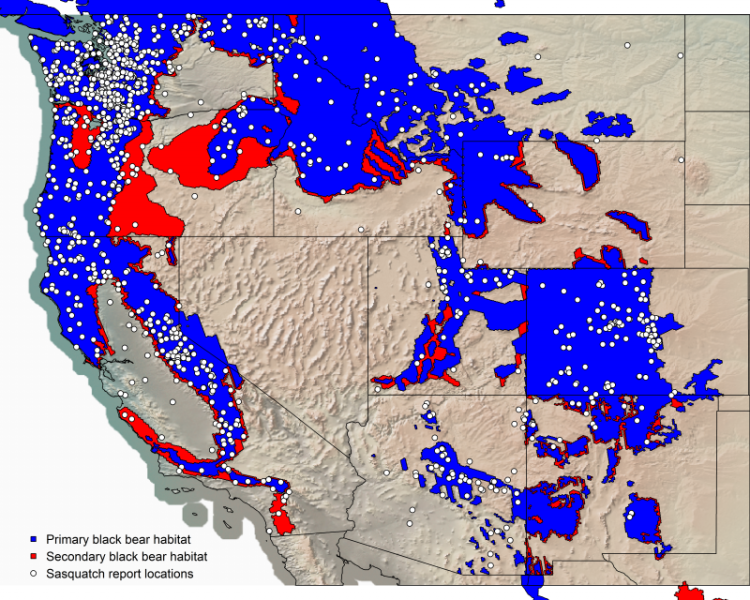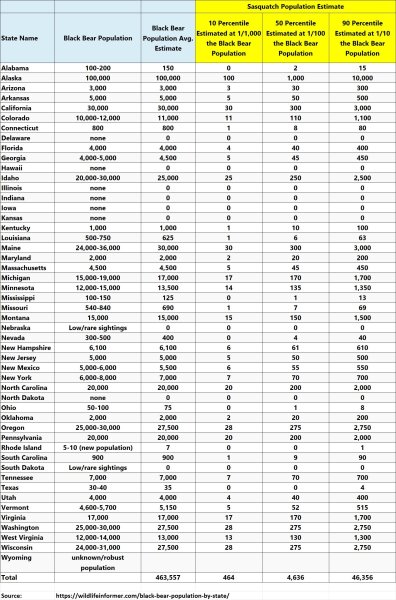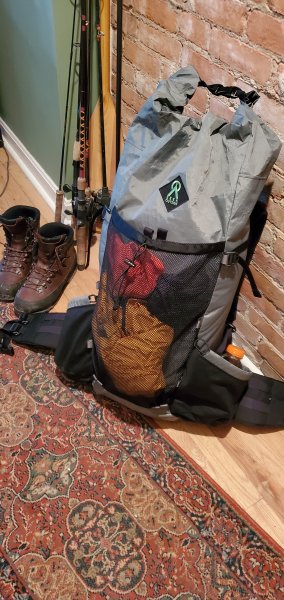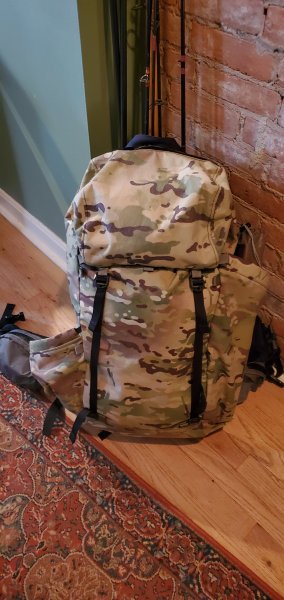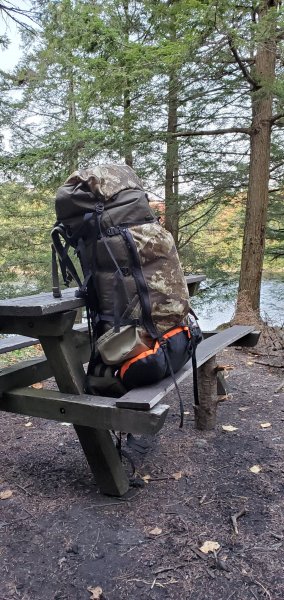Leaderboard
Popular Content
Showing content with the highest reputation on 03/27/2022 in all areas
-
Many of us in BFF have suggested in the past that sasquatch habitat is very similar to black bear habitat because they are usually found in the same places (with diversity of food and plenty of water sources). BugMaster created a map where he overlaid the sasquatch sighting reports over the black bear habitat in USA (see link below for his original posts). I am reposting his map, FYI. https://bigfootforums.com/topic/80034-species-distribution-model-and-ssr/?do=findComment&comment=1114768 One way of estimating sasquatch populations is to anchor on black bear populations and then estimate a range (10th to 90th percentiles) for the density ratio between sasquatch and black bears. My initial guesses are: P10 = Sasquatch density = 1/1,000 black bear density P50 = Sasquatch density = 1/100 black bear density P90 = Sasquatch density = 1/10 black bear density When we apply those ratios to the estimates of black bear populations by state we end up with the table below. It shows a black bear population in the USA of ~460,000 (excluding Wyoming that is missing the data). From this, the 80% confidence estimate for sasquatch population range from 460 to 46,000 with a median of 4,600. It helps to do a reality check by focusing on single states like WA and CA that have lots of sighting reports. For CA, the p10, p50, and p90 estimates for sasquatch population would be 30, 300, and 3,000. That looks like a reasonable broad range given the continued presence reports along the whole Sierra Nevada and up north in the Klamath National Forests. The range is similar for WA, with the p10, p50, and p90 estimates at 28, 280, and 2,800. The sasquatch population estimates appear low for such large states. Nonetheless, CA has a large human population while the number of public sighting reports per year is very low. Although, we truly do not know how many actual visual sightings occur every year in any state. I do not know how big a breeding sustainable sasquatch population has to be, but the p10 estimates appear too low for long term survival.2 points
-
Research into the sasquatch phenomenon for the past 50+ years has been dispersed, non-standardized, unorganized, and without any gate keeping organizations. Diversity of strategies, methodologies and groups is generally good in the initial stages of discovery because nobody knows anything with certainty about the subject and a wide-net diverse approach could yield more evidence. Nonetheless, as the years pass, we keep getting the same old pieces of evidence (anecdotal stories, casts of footprints, blurry photos (now in thermal), sound recordings, hairs (which analysis leads nowhere)) that are not conducive to scientific acceptance for the existence of this creature. Meanwhile, the community of field researchers have grown significantly since the mid 1990’s thanks to the internet, new organizations that made it possible to connect researchers, and TV shows treating the subject seriously. As a result, there are probably thousands of people in North America going into the field each year with similar ineffective tactics (placing game cameras, screaming BF like howls, sound blasting recordings of sasquatch, wood-knocking in the forests, walking at night with thermal imagers or night vision, looking for tracks and casting them, etc.). Many of these people just want to get the thrill of an experience and are not necessarily interested in the collection of evidence to prove the existence of this creature to the scientific community. There is nothing wrong with that. There are no accepted research protocols or standards, and every person is out there for get her/his own personal experience and contribution to the field. Stan Courtney tried to list all the sasquatch research organizations on his website, but the flux in and out is so high that many of the links do not work and he is probably missing many new organizations that pop in every year. http://www.stancourtney.com/squatchmarks.html One of the interesting aspects of the sasquatch research community is that not everyone has the same objectives. Some organizations and individuals would like to get a specimen and settle the mystery once and for all. While others just want to document their presence for themselves via audio, video, or photos, and don’t care what the scientific community thinks of this personal evidence. Others just want to experience their presence without documentation. Others (the habituators) want to establish communication and interaction with them without the collection of any evidence. Some might just want to set up YouTube videos of their walks in the forest, pointing out every tepee or glyph that they think a bigfoot created. Juxtaposed to the personal objectives of independent researchers are those of the national and statewide organizations. Sometimes these objectives align, and the groups grow, and sometimes they diverge and the groups break-up or shrink. Of interest are the mission statements and objectives of some of the best-known sasquatch organizations: BFRO: The overall mission of the BFRO is multifaceted, but the organization essentially seeks to resolve the mystery surrounding the bigfoot phenomenon, that is, to derive conclusive documentation of the species' existence. This goal is pursued through the proactive collection of empirical data and physical evidence from the field and by means of activities designed to promote an awareness and understanding of the nature and origin of the evidence. Olympic Project: The OP is an association of dedicated researchers, investigators, biologists, and trackers committed to documenting the existence of Sasquatch through science and education. Through comprehensive habitat study, DNA analysis and game camera deployment, our goal is to obtain as much information and empirical evidence as we can, with hopes of being as prepared as possible when and if species verification comes to fruition. Our studies are conducted in a non-invasive manner with respect and sensitivity to probable habitat we believe this amazing species inhabits. NAWAC: To investigate and conduct research regarding the existence of the unlisted primate species we refer to as the wood ape, also known as the sasquatch or bigfoot; to facilitate scientific, official, and governmental recognition, conservation, and protection of the species and its habitat; and to help further factual education and understanding to the public regarding the species, with a focus on the continent of North America. Our members are investigating one of the greatest natural enigmas of our time, and our main goal is to ultimately have the wood ape species documented, protected, and the land they inhabit protected. AIBR: The Alliance of Independent Bigfoot Researchers: The main thrust of AIBR research is dedicated to the scientific study of the creatures popularly known as bigfoot. The objective of AIBR is to collect, collate and document evidence using forensically sound, scientific procedures, and present the resulting evidence to mainstream scientists as part of an effort to prove the creature’s existence. A significant effort is made into documenting Native American references to these creatures. Of these 4 organizations, it seems that the AIBR was the one that could have helped the large diverse and disperse group of independent researchers across the US and Canada. Unfortunately, their website is no longer working. I don’t know if they are still active. I believe that Kathy Strain was one of the founders and might let us know what their situation is. If AIBR failed to get traction across North America, maybe it was because of the rugged individualism of the independent researchers and their lack of desire to join a group, share their findings, or be told how to conduct research properly. While the Olympic Project is making in-roads into the study of nests and implementation of e-DNA studies, we still have not seen any published papers from that effort. NAWAC published a monograph on their findings in the Ouachita Mountains, but they have not been able to capture a specimen or gotten video or photographs after 15 years in the target area. I am not sure if BFRO publishes any findings from their efforts. I have never seen a monograph published by BFRO on the evidence found to date from all their collective research efforts (but maybe it is out there buried in their website). As of 2022, I don’t see any changes coming afoot on the research methods and practices that will change the game and increase the odds of better evidence coming forward. Technology will continue to improve (drones, thermal imagers, game cameras, e-DNA testing, etc.) but I doubt they will change the outcome. Despite all the smart people that have contributed to the field and are continuously and creatively looking for new ways to get better evidence (from Washington to Florida and from Canada to Texas and all places in between), the community at large has not been able to crack the code. The odds are low that some new method or technique will arise that will change the game’s outcome, or the types of available evidence so far collected. I don’t think the problem is a lack of technology available to the researchers. The problem probably lies on flawed field research practices and methods. We could be making some wrong assumptions about the target’s capabilities, or the assumed hypothesis could be wrong. I don’t have the answers and just wanted to share my observations and misgivings.2 points
-
Fair enough. I have a different take-away though. My analogy is icebergs. 10% above the surface, 90% below .. give or take. I don't think it is our research practices or methods that are flawed, I think it is the assumptions that guide them .. a deeper, more fundamental flaw. We're not inept. I believe that if our assumptions were right, then our methods would have produced results. I don't know what the answer is but I am convinced that whatever it is, we're going to find that bigfoots aren't what we think they are. I think we need to step back and review the apparent crackpot theories. Apply some science to them looking for ways they could succeed, not just for ways to dismiss them. I think that because we are uncomfortable with aspects of them, we attempt to force failure so we don't have to face discomfort rather than looking into them to see how they might work thus suss out the answer to our mystery. You might even say we use "pure science" as a means to hide intellectual cowardice. MIB2 points
-
Thanks for sharing. I am no expert but, I certainly don't believe that these are made by man apes. In fact I don't think that they are of any significance.2 points
-
Hello from North East Texas. Been interested for years but now I have time to pursue my interest. I try to plan my motorcycle riding routes where sightings have been reported. I look forward to learning all I can.2 points
-
Good read, I am probably in the minority with this mindset, but to me searching and the mere act of discovery is essentially an act of violence towards these animals and I'm under the hard assumption that discovery won't come from any team that regularly make themselves targets and underestimate the intelligence of these primates, but from a lucky, unsuspecting hiker/hunter or motorist. It just seems this way to me. I don't like to romanticize this, but I think people regularly make the mistake of calling them "just animals" undermining their intelligence as greater apes because Apes are really smart as well as fully aware. They know stuff. Think Guerilla not Gorilla.1 point
-
A few questions that quickly come to mind on the subject I would need to think about. Maybe some food for thoughts for others. Its on of my favorite Sasquatch topics as I feel it is a huge piece of the puzzle. 1. What is the likely hood or of a witness reporting Sasquatch vs. bear and how does this effect reports? 2. Does Sasquatch intelligence hinder report numbers? Is Sasquatch intelligent??? 3. Food Sources and availability? How does this play into sighting reports for both species? 4. Are Sasquatch Migratory and or Nomadic? How could this play into reports? 5. Do they compete for territory / food source? 6. Breeding - All things encompassed in this, is there a season, litter size (I'd assume 1 typical, twins rare???), infant / young fatality rate. etc.1 point
-
Good Morning All, A little introduction about myself. From the UK I am a life long enthusiast of cryptozology and Bigfoot and moved over to the US in 2012. A keen outdoorsman and fella who enjoys survival and bushcraft the idea of a relict hominid still running about out there is very appealing. I think the biggest draw to this topic is the fact there are so many oral traditions of wildmen, Bigfoot, Oreng Pendeks etc around the world through history I feel there has to be something to it other than all hoaxes or misidentifications. Looking forward to speaking with people here to talk and debate new evidence or theories about BF!1 point
-
I'm a big fan of Seek Outside backpacks and the company recently introduced a new fabric they will be using. It's called Ultra 400 also referred to as Ultraweave or UltraPE. It is a woven blend of UHMWPE and 100% recycled polyester fibers and is a new fabric that is ridiculously light and multiple-times stronger and more abrasion resistance than fabrics used heretofore. The pack you see in the video above is XPac X-42. I have a pack in that material and another in XPac X-21 which is much lighter but is not as strong nor abrasion resistant. Solely in the interest of science, of course, I ordered a bag in Ultra 400 and will be able to compare it to the X-21 and X-42. All three of these fabrics are waterproof but the Ultra 400 is 8 times more abrasion resistant and 5 times stronger than the X-21, which is my current go-to pack. Amazingly, it will also be lighter. With the new bag, the entire backpack should weigh in around 2lbs 12oz yet have a load capability of 200lbs. More than my legs can haul. The bottom, with wear from abrasion, is always a weak link in a backpack but Ultra 400 should solve that concern. The fabric also comes in 200 which is lighter yet and what some of the ultralight-geared companies like ZPacks are adding into their repertoire. Some people wonder whether Dyneema (aka Cuben Fiber) is dead. I guess we'll see. I'll report back when the bag comes in and have had a chance to try it out in the field.1 point
-
Yes, you swap out just the bag. You remove the one bag and slide on the next one all on the same frame, belt, and shoulder harness. The only difference is the pack bag itself. The really nice thing about that is you can have different bags that do different things. Rather than have to buy a day pack, medium backpack and large backpack you simply buy one of their backpacks then just buy a different bag. I have an affinity for backpacks, so I have quite a few, but you could buy any one of their backpacks and then buy whatever other bag you want. The only thing you have to be mindful of is they have two formats of backpacks -- breakaway and integrated. Breakaway is for hunters who want to be able to put elk or deer meat in a bag. They can actual pull away the backpack from the frame and the bag contains the elk meat sits on a load shelf between the frame and the backpack. The Integrated format doesn't allow the separation of the bag from the frame. Other than that, you can pick and choose bags.1 point
-
One of the really good features of a Seek Outside backpack is your ability to swap in and out different bags. Earlier this year, I got a Gila model (57L in gray) from them earlier this year and it's super lightweight. It's my day and overnight backpack. A larger bag (camo) arrived yesterday that I had custom made by Seek Outside. It is a 79L bag with a tall side pocket which will hold a tent nicely. I removed the Gila bag and put on the new one...in a few minutes. It will be used for weekends. As you can see below, the larger bag rolls down into nothing and could easily be used as a daypack as well. The largest bag shown at the bottom, with top lid and face pocket, has a 130L capacity and is used on an extended backpacks. All three bags can fit on the same frame, belt, and shoulder-harness system. You just swap them in and out. All three packs can carry as much weight as your legs can carry.1 point
This leaderboard is set to New York/GMT-05:00





